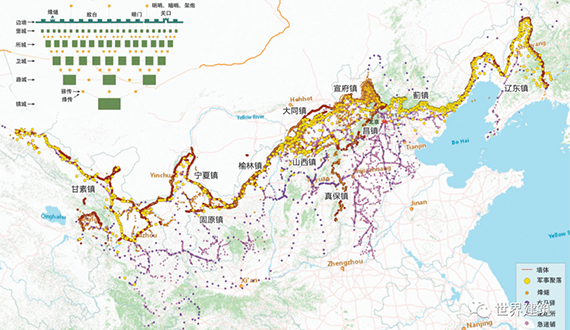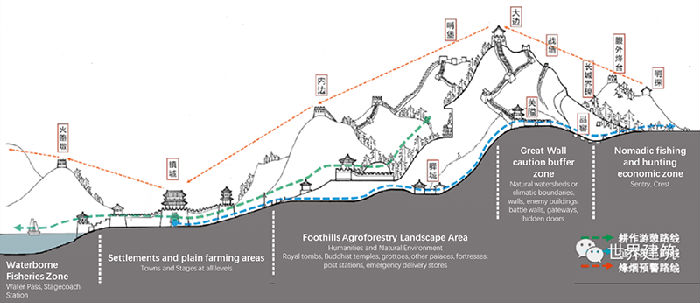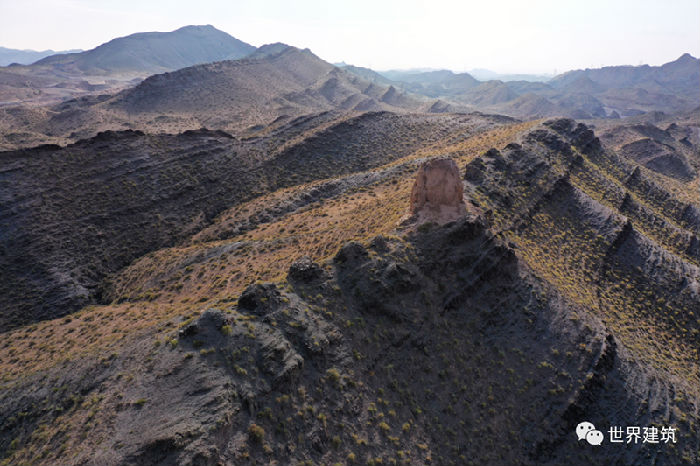


LI Yan, PhD, Associate Professor, School of Architecture, Tianjin University; Deputy Director, Key Laboratory of Architectural Cultural Heritage Inheritance Information, Ministry of Technology, Culture and Tourism, Tianjin, P. R. China.
ZHANG Yukun, PhD, Professor, School of Architecture, Tianjin University; Director, Key Laboratory of Architectural Cultural Heritage Inheritance Information, Ministry of Technology, Culture and Tourism, Tianjin, P. R. China.
LI Zhe, PhD, Associate Professor, School of Architecture, Tianjin University; Deputy Director, Key Laboratory of Architectural Cultural Heritage Inheritance Information, Ministry of Technology, Culture and Tourism, Tianjin, P. R. China.
Abstract: The Great Wall faces the problem of preservation and display due to its huge volume and incomplete remains. This paper introduces each component of the Great Wall system in detail and shows the progress of the digital reproduction project. The Great Wall Digital Reproduction Project Group has been working on information collection and basic research for 20 years, and has built online platforms such as the spatial database of the Ming Great Wall defense system, the continuous image and 3D database of the Ming Great Wall, prepared the exhibition outline of the Great Wall Museum of China, implemented the visualization of the Ming Great Wall system, architecture, and garrison, and helped to digitally reproduce the Ming Great Wall as a whole.
Keywords: Great Wall, holistic study, digitization
Introduction: Problems facing the holistic conservation of the Great Wall
The Great Wall is the largest architectural heritage in the world and has received widespread attention from the international community since its inscription as a World Heritage Site in 1987. Most of the international community's knowledge of the Great Wall comes from the UNESCO website, however, the introduction of the Great Wall on this website is limited to general descriptions and the three passages of Badaling, Shanhaiguan and Juyongguan1), which are only one of the components of the complex defense system of the Ming Great Wall, and the integrity has not yet been seen. In the past 100 years, UNESCO, ICOMOS, and the Council of Europe have adopted a series of important international documents on cultural heritage protection, gradually forming an international consensus on the protection of the authenticity and integrity of cultural heritage. The study of the authenticity and integrity of the cultural heritage of the Great Wall has also become an important event in reinterpreting the Great Wall and proclaiming its heritage value to the world.
For a long time, the public perception of the Great Wall was limited to the wall and the pass, and there was even a misconception that the Great Wall was a symbol of closed borders, but in fact, the Great Wall was never closed (Li et al., 2020), fireworks were not always set off at the top of the beacon towers, the Great Wall could not stop captivity (the city was the core strength of defense), and 1/3 of the Great Wall heritage was on the verge of disappearing. How can the integrity of the Great Wall be reflected? The article discusses the interpretation of the authenticity and reproduction of the integrity of the Great Wall from both theoretical and practical perspectives.
1.Holistic understanding of the value of the Great Wall
The Ming Great Wall military defense system is a holistic and systematic giant system composed of the border wall subsystem, the cantonment city subsystem, the postal transmission subsystem, the beacon transmission subsystem, the early warning subsystem, the border trade subsystem and the cantonment field subsystem. The Great Wall proper is the outermost defense line of the defense system formed by the wall and its appurtenant facilities, trenches, pin cellars and other fortifications together. Outside the wall there is an early warning system (open sentry, concealed sentry, erected cannon and beacon); above the wall there are four forms of facilities for communicating between inside and outside, such as pass city, strategic pass, concealed gate and water pass; inside the wall there is the citadel system, and the cantonment city subsystem undertakes the early warning, garrisoning and combat tasks (figure1)。

figure 1: Spatial distribution of the Ming Great Wall defense system
1.1Sidewall system
The total length of the Ming Great Wall is 8,851.8km, of which the artificial wall is 6,200km long. the border wall subsystem consists of the wall and the facilities on it, such as enemy platforms, wall platforms, pass city, strategic pass and concealed gates, which together assume the functions of daily lookout, organizing small-scale invasion, receiving early warning information and transmitting it to both sides and internal beacons.
The Great Wall was never a closed wall. The ancients left many channels in the wall to communicate between inside and outside, to maintain communication with the outside world, and to regulate the order of exchanging goods and transmitting information, guaranteeing the safety and security of important junctions (figure 2)。

figure 2: Defense facilities schematic
1.2 cantonment city subsystem
The border town system was divided into five tiers according to military rank. There were 1,091 cantonment cities on the Ming Great Wall, including 13 town cities, 54 road cities, 87 major military cities, 64 minor military cities, and 1,048 fortress cities (Li et al., 2018)。 The various cantonment cities were not isolated, and mutual assistance and coordination between the cities were key to ensuring timely military response and the implementation of the defensive role (Figure 3)。

figure 3: Example of the current status of each level of cantonment city
The town city was the highest-ranking city in a town, built on flat terrain on a major transport route, with a square or rectangular plan and a circumference of 6 km or more. Xuanhua, a major defensive town, has a perimeter of 12 km. The town has a minimum number of four gates and the roads can be divided into main roads, general streets and lanes. The main roads are cross-shaped, with important government offices and military command buildings on both sides of the main roads, commercial areas with shops at the intersections of the main roads and streets, and major temples and monasteries on both sides of the streets and lanes.
The size of the road town is smaller than that of the town city, with a roughly square plan and a perimeter of between 2 and 4 kilometers. The road structure of the road town is divided into two levels: the main road and the lane, and the main road is in the shape of a cross, corresponding to each city gate. Most of the road towns have 4 gates, while some have 2 gates and have urn cities at the main gates.
The major military city is a military garrison of the town, the main function of which is to store troops and food, smaller than the town city and larger than the minor military cities, fortress cities. The circumference of the city is 2~3.5 km, and the full strength of the city is 5600 people. The city has 2~4 gates, the roads are divided into streets and alleys, and combined to form a cross structure, of which the main street leading to the gate is wide and smooth. In addition, the road around the city is also built on the inner side of the city wall according to the ancient system.
The minor military city was a military garrison for the major military city, with 1120 soldiers, larger than the fortress city. The city plan is mainly square, mostly around 2 km in circumference, with the main roads being cross-shaped or linear, "ring roads" along the inner side of the city walls, and more than 3 doors open. Public offices, warehouses, and military hangars were mostly set up on both sides of the main roads.
The fortress city is the most basic defense unit, the smallest in size, with 112 troops stationed there. The perimeter of the city is 0.5-2 km, with one, two or three gates, and the main gate is also equipped with an urn. The topography of the fortress is generally complex, with some located on top of high mountains, some in valleys, and slopes with the mountains, the regular shape of the fortress is square or rectangular, and the irregular shape varies. The streets of the larger cities are cross-shaped, while the smaller ones are linear.
1.3the postal transmission subsystem
The post stations, delivery offices and urgent delivery stores, as well as the roads between the post, the delivery and the stores, were the "transportation network" that supported the entire Great Wall defense system.
The water and horse post was the first major level of the post system, mainly responsible for the transmission of important military and emergency documents, the transmission of government orders, the movement of official personnel, and the reception of ambassadors and officials, and the provision of resting places. The speed of post-transmission was fast, and horses and mules were used as transportation for land transmission, while boats were used for water transportation. The distance between neighboring post stations in the Ming Dynasty was generally 30 or 40 kilometers.
The delivery office was an institution specializing in the transportation of military supplies and tributes and other materials during the Ming Dynasty. The delivery office was divided into three types: land delivery, water delivery, and water and land delivery (both water and land)。 The delivery office had one ambassador and one deputy ambassador, and another centurion. The land route was handled by the soldiers, and the water route was handled by the boat operators in each area. The method of fixed point, fixed line, and also relay was adopted. The Ming Dynasty delivery office achieved a good combination of land and water transport. However, in the middle and late Ming Dynasty, due to its function of transporting materials being replaced by post stations and excessive expenses of the state treasury, the delivery offices suffered a lot of layoffs.
The urgent delivery store was the third level of the post system, with one store for ten miles, responsible for both military information and daily official documents, and was widely distributed along the Great Wall. The way of transmitting information was by foot, and the paved soldiers were responsible for official documents, which could go deep into the cities and towns that were difficult to be reached by post stations, or in mountainous areas with large slopes.
1.4 Beacon Transmission System
The beacon system is mainly composed of beacon towers, which are connected one by one and look at each other from a distance, stretching across the mountains and valleys and basins (figure 4)。

Figure 4: Beacon towers and attached flint near Helan Mountain, Ningxia
The beacon platform is distributed according to the principle of "evenly placed", and can be divided into pier platform along the edge, fire receiving platform outside the belly and fire receiving platform in the belly according to the position relationship with the side wall. When the enemy is encountered, the beacon stations are relayed one by one, and the information is transmitted from the Great Wall to all levels of the city according to the level of alarm.
Military information is crucial to the operation of system functions such as arming, dispatching, response and support of soldiers and horses. There are two main modes of information transmission between beacons: transmission by platform and transmission across platforms. Passing by stage is relatively simple, and passing across platforms is mostly found on the Great Wall line or in the case of close distance of beacon, in order to prevent the problem of error rate rising due to too many times of passing. The speed of beacon transmission is fast and the distance is long, the basic carrier of information is beacon and wolf smoke, and the transmission mode is mainly burning smoke during the day and holding fire at night. In the middle and late Ming Dynasty, the way of firing cannons, raising flags and hanging lights are gradually added to optimize the transmission mode.
1.5 Early Warning System
In addition to the beacon system, the scouting system is also part of the early warning. The scouting system is responsible for military intelligence reconnaissance outside the border, and plays a pivotal role in both ancient and modern wars.
In Jizhen, for example, the hierarchical relationship of the scouting system from the outside to the inside was: open sentry - concealed sentry - erected gun - pier beacons. Ming sentries were spies sent by the Ming border army to the interior of nomadic tribes, located in the enemy's hinterland, to spy on enemy movements. The Ming sentries passed information to the concealed sentries lurking outside and entered the inner side of the Great Wall through hidden concealed doors set in the wall. The concealed sentry transmits information back to the army through the cannons, which are usually set up on the peaks on both sides of the valley to transmit information while monitoring the number of enemy troops in the valley and their direction of march. Eventually the information reached the piers along the edge and entered the beacon transmission system (Li, Zhang, & Li, 2018)。
1.6 The border trade subsystem
Since the beginning of the Han Dynasty, the mutual market with the nature of border trade and military activities have been the two most common communication states inside and outside the Great Wall. In the middle and early Ming dynasty, trade along the Great Wall was mainly between the Ming dynasty and Mongolia and the Jurchens in the form of horse market, wood market, cloth market, etc. Dozens of Ming Dynasty mutual market relics still exist along the Great Wall, of which the pattern and scale of the horse market is diverse. To ensure orderly trading, market forts were generally equipped with independent entrances and exits, and tall horse market buildings were built to monitor trading activities and prevent attacks; multiple gates were set up at the entrance to prevent various illegal acts such as entrapment and smuggling (Li, Xie, Tuo, Zhang, & Li, 2020) (Figure 5)。

Figure 5: Distribution of mutual markets along the Great Wall during the Ming Dynasty
1.7 the cantonment field subsystem
In the Ming Dynasty, the guard system was implemented at the local level, and the soldiers of the guard reclaimed wastelands outside the jurisdiction of the prefectures, states, and counties and practiced cantonment, called military cantonment. At the beginning of the Ming Dynasty, the number of cantonment soldiers in the nine borders was maintained at 420,000-560,000 year-round, and the area of cantonment was over 210,000 hectares, accounting for about 35% of the total amount of cantonment land in the country (Liu, 2016)。 The military cantonments were managed as a self-contained system, with special cantonment guards, cantonment forts, and a large number of cantonment troops allocated to farming. In the mid-Ming period, military cantonments gradually declined, and civilian and commercial cantonments gradually developed as an adjunct to military cantonments in a wide area along the Great Wall. As an important part of the military defense system of the Great Wall, the cantonments strengthened the border defense; they also partially solved the problem of food and wages for the huge local garrison and objectively contributed to the economic and cultural development of the Great Wall region.
Note
1)UNESCO website <http://www.unesco.org/>
References
Li, Y., Zhang, Y., & Li, Z. (2018)。 A Study of the Ming Great Wall Defense System and Military Settlements. Architectural Journal.
Li, Y., Zhang, Y., & Xie, D. (2018)。 Ming Great Wall Defense System and Military Settlements. Beijing Yanshang Press.
Li, Z, Tuo, X., Jing, Y., Li, Y., & Yao, W. (2020)。 The Investigation of Distribution, Category and Usage of Hidden Doors: Along the jizhen defensive district of the Ming Great Wall. Architectural Journal.
Li, Z., Xie, J., Tuo, X., Zhang, Y., & Li, Y. (2020)。 Spatial Study of Horse Markets Along the Ming Great Wall. Architectural Journal.
Liu, Q. (2016)。 The Great Wall of China. Phoenix Science Press.
Source:< <https://mp.weixin.qq.com/s/NKKy0VIFoT-_WtXy9zxCZg》
Translated by Hou Ying